梯度下降法实现(Python语言描述)
原文地址:传送门
import numpy as np
import matplotlib.pyplot as plt
%matplotlib inline
plt.style.use(['ggplot'])
当你初次涉足机器学习时,你学习的第一个基本算法就是 梯度下降 (Gradient Descent), 可以说梯度下降法是机器学习算法的支柱。 在这篇文章中,我尝试使用
p
y
t
h
o
n
python
python 解释梯度下降法的基本原理。一旦掌握了梯度下降法,很多问题就会变得容易理解,并且利于理解不同的算法。
如果你想尝试自己实现梯度下降法, 你需要加载基本的
p
y
t
h
o
n
python
python
p
a
c
k
a
g
e
s
packages
packages ——
n
u
m
p
y
numpy
numpy and
m
a
t
p
l
o
t
l
i
b
matplotlib
matplotlib
首先, 我们将创建包含着噪声的线性数据
# 随机创建一些噪声
X = 2 * np.random.rand(100, 1)
y = 4 + 3 * X + np.random.randn(100, 1)
接下来通过 matplotlib 可视化数据
# 可视化数据
plt.plot(X, y, 'b.')
plt.xlabel("$x$", fontsize=18)
plt.ylabel("$y$", rotation=0, fontsize=18)
plt.axis([0, 2, 0, 15])

显然,
y
y
y 与
x
x
x 具有良好的线性关系,这个数据非常简单,只有一个自变量
x
x
x.
我们可以将其表示为简单的线性关系:
y
=
b
+
m
x
y = b + mx
y=b+mx
并求出
b
b
b ,
m
m
m。
这种被称为解方程的分析方法并没有什么不妥,但机器学习是涉及矩阵计算的,因此我们使用矩阵法(向量法)进行分析。
我们将
y
y
y 替换成
J
(
θ
)
J(\theta)
J(θ),
b
b
b 替换成
θ
0
\theta_0
θ0,
m
m
m 替换成
θ
1
\theta_1
θ1。
得到如下表达式:
J
(
θ
)
=
θ
0
+
θ
1
x
J(\theta) = \theta_0 + \theta_1 x
J(θ)=θ0+θ1x
注意: 本例中
θ
0
=
4
\theta_0= 4
θ0=4,
θ
1
=
3
\theta_1= 3
θ1=3
求解
θ
0
\theta_0
θ0 和
θ
1
\theta_1
θ1 的分析方法,代码如下:
X_b = np.c_[np.ones((100, 1)), X] # 为X添加了一个偏置单位,对于X中的每个向量都是1
theta_best = np.linalg.inv(X_b.T.dot(X_b)).dot(X_b.T).dot(y)
theta_best
array([[3.86687149],
[3.12408839]])
不难发现这个值接近真实的
θ
0
\theta_0
θ0,
θ
1
\theta_1
θ1,由于我在数据中引入了噪声,所以存在误差。
X_new = np.array([[0], [2]])
X_new_b = np.c_[np.ones((2, 1)), X_new]
y_predict = X_new_b.dot(theta_best)
y_predict
array([[ 3.86687149],
[10.11504826]])
梯度下降法 (Gradient Descent)
Cost Function & Gradients
计算代价函数和梯度的公式如下所示。
注意:代价函数用于线性回归,对于其他算法,代价函数是不同的,梯度必须从代价函数中推导出来。
Cost
J
(
θ
)
=
1
/
2
m
∑
i
=
1
m
(
h
(
θ
)
(
i
)
−
y
(
i
)
)
2
J(\theta) = 1/2m \sum_{i=1}^{m} (h(\theta)^{(i)} - y^{(i)})^2
J(θ)=1/2mi=1∑m(h(θ)(i)−y(i))2
Gradient
∂
J
(
θ
)
∂
θ
j
=
1
/
m
∑
i
=
1
m
(
h
(
θ
(
i
)
−
y
(
i
)
)
.
X
j
(
i
)
\frac{\partial J(\theta)}{\partial \theta_j} = 1/m\sum_{i=1}^{m}(h(\theta^{(i)} - y^{(i)}).X_j^{(i)}
∂θj∂J(θ)=1/mi=1∑m(h(θ(i)−y(i)).Xj(i)
Gradients
θ
0
:
=
θ
0
−
α
.
(
1
/
m
.
∑
i
=
1
m
(
h
(
θ
(
i
)
−
y
(
i
)
)
.
X
0
(
i
)
)
\theta_0: = \theta_0 -\alpha . (1/m .\sum_{i=1}^{m}(h(\theta^{(i)} - y^{(i)}).X_0^{(i)})
θ0:=θ0−α.(1/m.i=1∑m(h(θ(i)−y(i)).X0(i))
θ
1
:
=
θ
1
−
α
.
(
1
/
m
.
∑
i
=
1
m
(
h
(
θ
(
i
)
−
y
(
i
)
)
.
X
1
(
i
)
)
\theta_1: = \theta_1 -\alpha . (1/m .\sum_{i=1}^{m}(h(\theta^{(i)} - y^{(i)}).X_1^{(i)})
θ1:=θ1−α.(1/m.i=1∑m(h(θ(i)−y(i)).X1(i))
θ
2
:
=
θ
2
−
α
.
(
1
/
m
.
∑
i
=
1
m
(
h
(
θ
(
i
)
−
y
(
i
)
)
.
X
2
(
i
)
)
\theta_2: = \theta_2 -\alpha . (1/m .\sum_{i=1}^{m}(h(\theta^{(i)} - y^{(i)}).X_2^{(i)})
θ2:=θ2−α.(1/m.i=1∑m(h(θ(i)−y(i)).X2(i))
θ
j
:
=
θ
j
−
α
.
(
1
/
m
.
∑
i
=
1
m
(
h
(
θ
(
i
)
−
y
(
i
)
)
.
X
0
(
i
)
)
\theta_j: = \theta_j -\alpha . (1/m .\sum_{i=1}^{m}(h(\theta^{(i)} - y^{(i)}).X_0^{(i)})
θj:=θj−α.(1/m.i=1∑m(h(θ(i)−y(i)).X0(i))
def cal_cost(theta, X, y):
'''
Calculates the cost for given X and Y. The following shows and example of a single dimensional X
theta = Vector of thetas
X = Row of X's np.zeros((2,j))
y = Actual y's np.zeros((2,1))
where:
j is the no of features
'''
m = len(y)
predictions = X.dot(theta)
cost = (1/2*m) * np.sum(np.square(predictions - y))
return cost
def gradient_descent(X, y, theta, learning_rate = 0.01, iterations = 100):
'''
X = Matrix of X with added bias units
y = Vector of Y
theta=Vector of thetas np.random.randn(j,1)
learning_rate
iterations = no of iterations
Returns the final theta vector and array of cost history over no of iterations
'''
m = len(y)
# learning_rate = 0.01
# iterations = 100
cost_history = np.zeros(iterations)
theta_history = np.zeros((iterations, 2))
for i in range(iterations):
prediction = np.dot(X, theta)
theta = theta - (1/m) * learning_rate * (X.T.dot((prediction - y)))
theta_history[i, :] = theta.T
cost_history[i] = cal_cost(theta, X, y)
return theta, cost_history, theta_history
# 从1000次迭代开始,学习率为0.01。从高斯分布的θ开始
lr =0.01
n_iter = 1000
theta = np.random.randn(2, 1)
X_b = np.c_[np.ones((len(X), 1)), X]
theta, cost_history, theta_history = gradient_descent(X_b, y, theta, lr, n_iter)
print('Theta0: {:0.3f},\nTheta1: {:0.3f}'.format(theta[0][0],theta[1][0]))
print('Final cost/MSE: {:0.3f}'.format(cost_history[-1]))
Theta0: 3.867,
Theta1: 3.124
Final cost/MSE: 5457.747
# 绘制迭代的成本图
fig, ax = plt.subplots(figsize=(12,8))
ax.set_ylabel('J(Theta)')
ax.set_xlabel('Iterations')
ax.plot(range(1000), cost_history, 'b.')
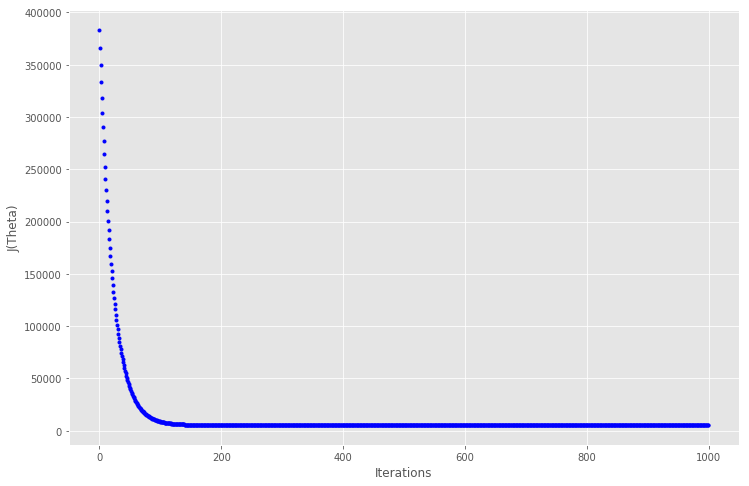
在大约 150 次迭代之后代价函数趋于稳定,因此放大到迭代200,看看曲线
fig, ax = plt.subplots(figsize=(10,8))
ax.plot(range(200), cost_history[:200], 'b.')
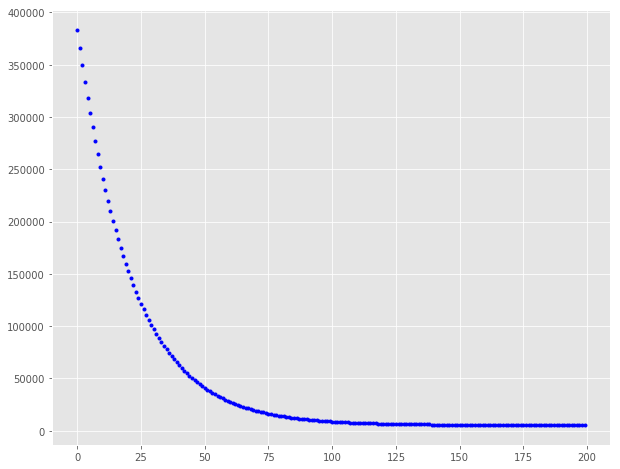
值得注意的是,最初成本下降得更快,然后成本降低的收益就不那么多了。 我们可以尝试使用不同的学习速率和迭代组合,并得到不同学习率和迭代的效果会如何。
让我们建立一个函数,它可以显示效果,也可以显示梯度下降实际上是如何工作的。
def plot_GD(n_iter, lr, ax, ax1=None):
'''
n_iter = no of iterations
lr = Learning Rate
ax = Axis to plot the Gradient Descent
ax1 = Axis to plot cost_history vs Iterations plot
'''
ax.plot(X, y, 'b.')
theta = np.random.randn(2, 1)
tr = 0.1
cost_history = np.zeros(n_iter)
for i in range(n_iter):
pred_prev = X_b.dot(theta)
theta, h, _ = gradient_descent(X_b, y, theta, lr, 1)
pred = X_b.dot(theta)
cost_history[i] = h[0]
if ((i % 25 == 0)):
ax.plot(X, pred, 'r-', alpha=tr)
if tr < 0.8:
tr += 0.2
if not ax1 == None:
ax1.plot(range(n_iter), cost_history, 'b.')
# 绘制不同迭代和学习率组合的图
fig = plt.figure(figsize=(30,25), dpi=200)
fig.subplots_adjust(hspace=0.4, wspace=0.4)
it_lr = [(2000, 0.001), (500, 0.01), (200, 0.05), (100, 0.1)]
count = 0
for n_iter, lr in it_lr:
count += 1
ax = fig.add_subplot(4, 2, count)
count += 1
ax1 = fig.add_subplot(4, 2, count)
ax.set_title("lr:{}" .format(lr))
ax1.set_title("Iterations:{}" .format(n_iter))
plot_GD(n_iter, lr, ax, ax1)
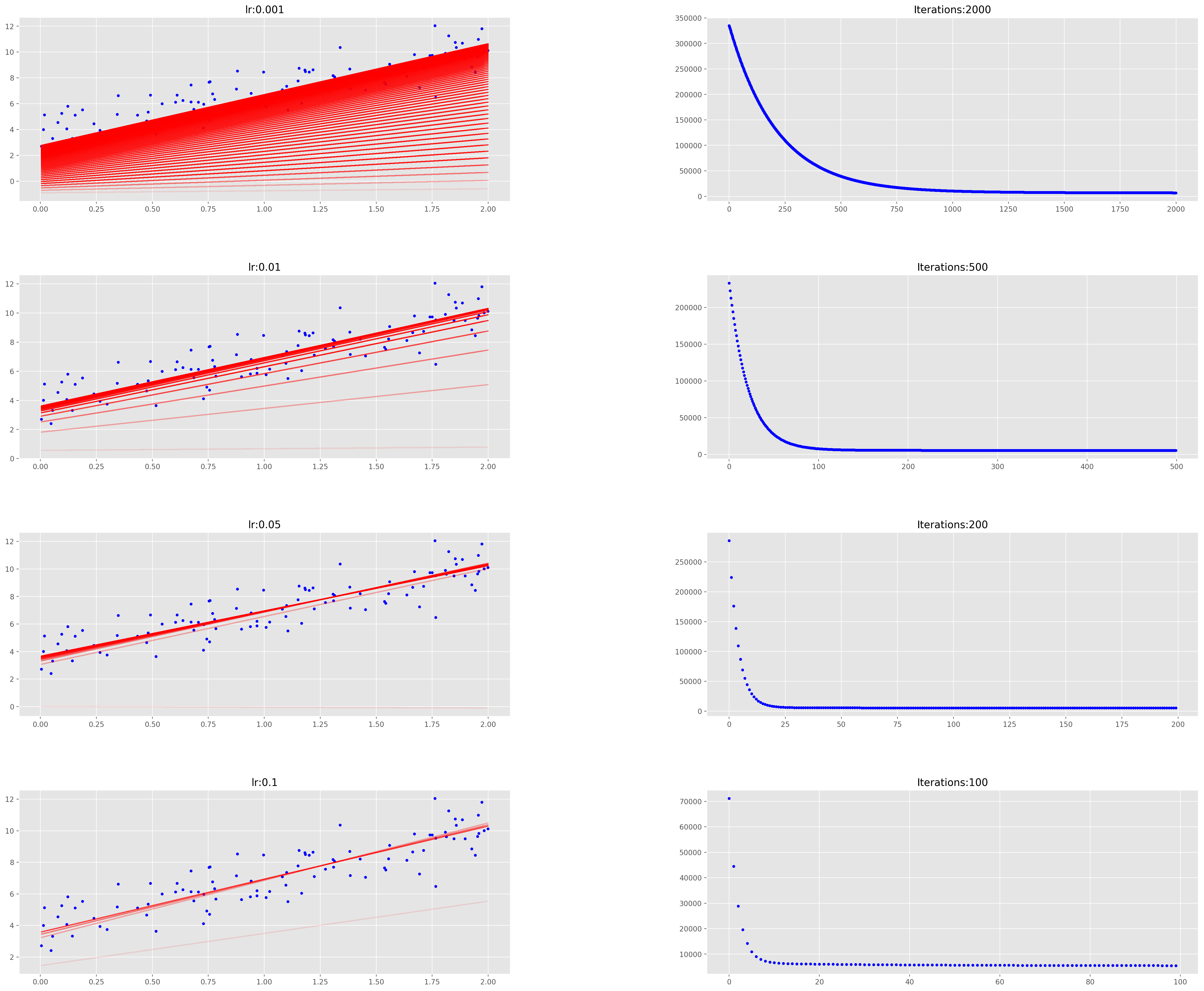
通过观察发现,以较小的学习速率收集解决方案需要很长时间,而学习速度越大,学习速度越快。
_, ax = plt.subplots(figsize=(14, 10))
plot_GD(100, 0.1, ax)
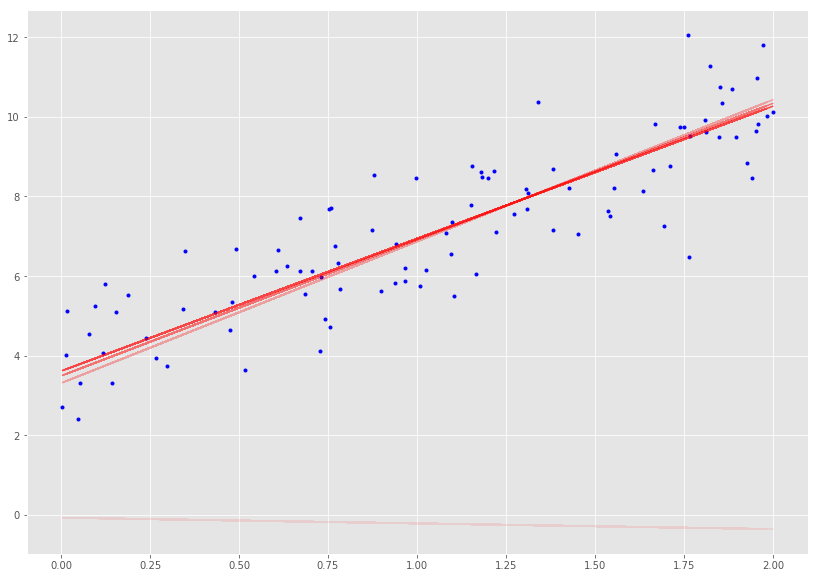
随机梯度下降法(Stochastic Gradient Descent)
随机梯度下降法,其实和批量梯度下降法原理类似,区别在与求梯度时没有用所有的
m
m
m 个样本的数据,而是仅仅选取一个样本
j
j
j 来求梯度。对应的更新公式是:
θ
i
=
θ
i
−
α
(
h
θ
(
x
0
(
j
)
,
x
1
(
j
)
,
.
.
.
x
n
(
j
)
)
−
y
j
)
x
i
(
j
)
\theta_i = \theta_i - \alpha (h_\theta(x_0^{(j)}, x_1^{(j)}, ...x_n^{(j)}) - y_j)x_i^{(j)}
θi=θi−α(hθ(x0(j),x1(j),...xn(j))−yj)xi(j)
def stocashtic_gradient_descent(X, y, theta, learning_rate=0.01, iterations=10):
'''
X = Matrix of X with added bias units
y = Vector of Y
theta=Vector of thetas np.random.randn(j,1)
learning_rate
iterations = no of iterations
Returns the final theta vector and array of cost history over no of iterations
'''
m = len(y)
cost_history = np.zeros(iterations)
for it in range(iterations):
cost = 0.0
for i in range(m):
rand_ind = np.random.randint(0, m)
X_i = X[rand_ind, :].reshape(1, X.shape[1])
y_i = y[rand_ind, :].reshape(1, 1)
prediction = np.dot(X_i, theta)
theta -= (1/m) * learning_rate * (X_i.T.dot((prediction - y_i)))
cost += cal_cost(theta, X_i, y_i)
cost_history[it] = cost
return theta, cost_history
lr = 0.5
n_iter = 50
theta = np.random.randn(2,1)
X_b = np.c_[np.ones((len(X),1)), X]
theta, cost_history = stocashtic_gradient_descent(X_b, y, theta, lr, n_iter)
print('Theta0: {:0.3f},\nTheta1: {:0.3f}' .format(theta[0][0],theta[1][0]))
print('Final cost/MSE: {:0.3f}' .format(cost_history[-1]))
Theta0: 3.762,
Theta1: 3.159
Final cost/MSE: 46.964
fig, ax = plt.subplots(figsize=(10,8))
ax.set_ylabel('$J(\Theta)$' ,rotation=0)
ax.set_xlabel('$Iterations$')
theta = np.random.randn(2,1)
ax.plot(range(n_iter), cost_history, 'b.')
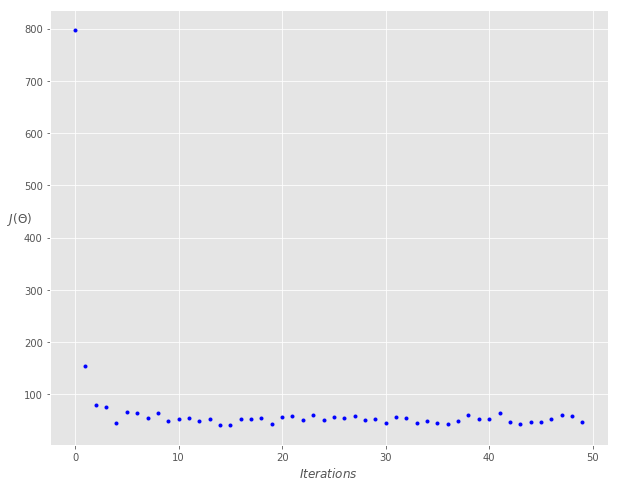
小批量梯度下降法(Mini-batch Gradient Descent)
小批量梯度下降法是批量梯度下降法和随机梯度下降法的折衷,也就是对于
m
m
m 个样本,我们采用x个样子来迭代,
1
<
x
<
m
1<x<m
1<x<m。一般可以取
x
=
10
x=10
x=10,当然根据样本的数据,可以调整这个
x
x
x 的值。对应的更新公式是:
θ
i
=
θ
i
−
α
∑
j
=
t
t
+
x
−
1
(
h
θ
(
x
0
(
j
)
,
x
1
(
j
)
,
.
.
.
x
n
(
j
)
)
−
y
j
)
x
i
(
j
)
\theta_i = \theta_i - \alpha \sum\limits_{j=t}^{t+x-1}(h_\theta(x_0^{(j)}, x_1^{(j)}, ...x_n^{(j)}) - y_j)x_i^{(j)}
θi=θi−αj=t∑t+x−1(hθ(x0(j),x1(j),...xn(j))−yj)xi(j)
def minibatch_gradient_descent(X, y, theta, learning_rate=0.01, iterations=10, batch_size=20):
'''
X = Matrix of X without added bias units
y = Vector of Y
theta=Vector of thetas np.random.randn(j,1)
learning_rate
iterations = no of iterations
Returns the final theta vector and array of cost history over no of iterations
'''
m = len(y)
cost_history = np.zeros(iterations)
n_batches = int(m / batch_size)
for it in range(iterations):
cost = 0.0
indices = np.random.permutation(m)
X = X[indices]
y = y[indices]
for i in range(0, m, batch_size):
X_i = X[i: i+batch_size]
y_i = y[i: i+batch_size]
X_i = np.c_[np.ones(len(X_i)), X_i]
prediction = np.dot(X_i, theta)
theta -= (1/m) * learning_rate * (X_i.T.dot((prediction - y_i)))
cost += cal_cost(theta, X_i, y_i)
cost_history[it] = cost
return theta, cost_history
lr = 0.1
n_iter = 200
theta = np.random.randn(2, 1)
theta, cost_history = minibatch_gradient_descent(X, y, theta, lr, n_iter)
print('Theta0: {:0.3f},\nTheta1: {:0.3f}' .format(theta[0][0], theta[1][0]))
print('Final cost/MSE: {:0.3f}' .format(cost_history[-1]))
Theta0: 3.842,
Theta1: 3.146
Final cost/MSE: 1090.518
fig, ax = plt.subplots(figsize=(10,8))
ax.set_ylabel('$J(\Theta)$', rotation=0)
ax.set_xlabel('$Iterations$')
theta = np.random.randn(2, 1)
ax.plot(range(n_iter), cost_history, 'b.')

参考:
梯度下降法实现(Python语言描述)的更多相关文章
- 梯度下降法的python代码实现(多元线性回归)
梯度下降法的python代码实现(多元线性回归最小化损失函数) 1.梯度下降法主要用来最小化损失函数,是一种比较常用的最优化方法,其具体包含了以下两种不同的方式:批量梯度下降法(沿着梯度变化最快的方向 ...
- 梯度下降法实现-python[转载]
转自:https://www.jianshu.com/p/c7e642877b0e 梯度下降法,思想及代码解读. import numpy as np # Size of the points dat ...
- (转)梯度下降法及其Python实现
梯度下降法(gradient descent),又名最速下降法(steepest descent)是求解无约束最优化问题最常用的方法,它是一种迭代方法,每一步主要的操作是求解目标函数的梯度向量,将当前 ...
- 固定学习率梯度下降法的Python实现方案
应用场景 优化算法经常被使用在各种组合优化问题中.我们可以假定待优化的函数对象\(f(x)\)是一个黑盒,我们可以给这个黑盒输入一些参数\(x_0, x_1, ...\),然后这个黑盒会给我们返回其计 ...
- paper 166:梯度下降法及其Python实现
参考来源:https://blog.csdn.net/yhao2014/article/details/51554910 梯度下降法(gradient descent),又名最速下降法(steepes ...
- 简单线性回归(梯度下降法) python实现
grad_desc .caret, .dropup > .btn > .caret { border-top-color: #000 !important; } .label { bord ...
- 《数据结构与算法Python语言描述》习题第二章第三题(python版)
ADT Rational: #定义有理数的抽象数据类型 Rational(self, int num, int den) #构造有理数num/den +(self, Rational r2) #求出本 ...
- 《数据结构与算法Python语言描述》习题第二章第二题(python版)
ADT Date: #定义日期对象的抽象数据类型 Date(self, int year, int month, int day) #构造表示year/month/day的对象 difference( ...
- 《数据结构与算法Python语言描述》习题第二章第一题(python版)
题目:定义一个表示时间的类Timea)Time(hours,minutes,seconds)创建一个时间对象:b)t.hours(),t.minutes(),t.seconds()分别返回时间对象t的 ...
随机推荐
- 基于TSN 802.1AS协议的时间同步分析(7种延时,1次厘清)
前言 往期的时间同步--802.1AS协议介绍一文向大家介绍了802.1AS协议的基本内容,基于时间同步协议就能实现主节点与各从节点的时间同步,但是如何评价时间同步的优劣呢?这就需要我们通过一些时间同 ...
- [BUUCTF]PWN——others_babystack
others_babystack 附件 步骤: 例行检查,64位程序,开了挺多保护 本地试运行一下程序 64位ida载入,看main函数 1是read函数,存在栈溢出:2是puts函数,3退出 利用思 ...
- 任务关联的类型(Project)
<Project2016 企业项目管理实践>张会斌 董方好 编著 任务关联的类型,一共是四种,FS.SS.SF.FF. 就这些! -- 好吧,我又调皮了,怎么着也该解释一下吧? 嗯!F就是 ...
- 数组队列如何手撕?解密ArrayBlockingQueue的实现内幕!
队列 聊起队列,你一定会联想到一个与队列相似的数据结构:栈. 为了更好的理解什么是队列,我们将它和栈来比较一下: 队列的特点是:先进先出,如下图,1先进,1就先出. 图1:队列的图解 栈的特点是:先进 ...
- linux查看磁盘SN
ls -l /dev/disk/by-id/ | grep -iE <SN>
- IPtables 之“四表五链”
目录 架构图 IP tables 简介 包过滤防火墙 Iptables如何过滤 "四表" "五链" Iptables流程 架构图 公司架构模式(酒店迎宾比喻) ...
- sql改写优化:简单规则重组实现
我们知道sql执行是一个复杂的过程,从sql到逻辑计划,到物理计划,规则重组,优化,执行引擎,都是很复杂的.尤其是优化一节,更是内容繁多.那么,是否我们本篇要来讨论这个问题呢?答案是否定的,我们只特定 ...
- 【LeetCode】1185. Day of the Week 解题报告(C++)
作者: 负雪明烛 id: fuxuemingzhu 个人博客:http://fuxuemingzhu.cn/ 目录 题目描述 题目大意 解题方法 计算与1971-1-1之间天数 日期 题目地址:htt ...
- 【LeetCode】1119. Remove Vowels from a String 解题报告(C++)
作者: 负雪明烛 id: fuxuemingzhu 个人博客:http://fuxuemingzhu.cn/ 目录 题目描述 题目大意 解题方法 判断字符是否是aeiou 日期 题目地址:https: ...
- 【LeetCode】346. Moving Average from Data Stream 解题报告(C++)
作者: 负雪明烛 id: fuxuemingzhu 个人博客:http://fuxuemingzhu.cn/ 目录 题目描述 题目大意 解题方法 队列 日期 题目地址:https://leetcode ...
